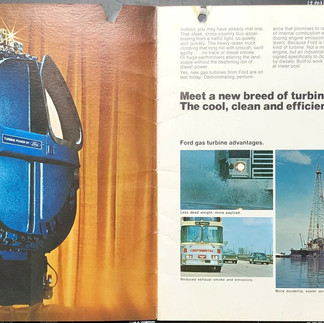Turbine Power!
- John Mario
- Dec 21, 2023
- 5 min read
Updated: Dec 21, 2023

Ever since I got into early fiberglass cruisers, I was enamored with the little-known blip of an engine program called the marine gas turbine. Throughout the 20th century, there were many prototype propulsion programs spread across automakers to compete with the tried-and-true internal combustion engine.
Perhaps the most popular of these programs was Ford’s turbine program which gained popularity in the mid 1960’s. Ford spent nearly two decades of research starting in the 1950s to develop a gas turbine engine that could compete with traditional diesel engines in heavy trucks. At the time, Ford claimed that their gas turbine created less vibration, produced fewer emissions, used less oil, and produced higher torque at lower speeds when compared to its diesel competitor. Ford did a “rolling” campaign using its “Big Red” turbine-powered heavy truck where it toured the country demonstrating itself as a worthy successor to its diesel-powered counterparts. There are many articles written about Big Red and readily available on the Internet so I will not go into detail here. What I will go into detail on is how programs like this almost made it into some of the production cruisers we know and love.
I will premise the remainder of this blog by saying I do not have the whole story. Truth be told, I don’t think anyone really does. What I have done is research what documentation is available and talk with a couple of people who claim to have seen bits and pieces of this technology in the wild.
When I started my investigation, I thought that Chris Craft was the only cruiser-class boat builder entertaining the prospect of turbine power. However, after my research I found that Pacemaker was also in the running. This was to be the marine propulsion Coke vs. Pepsi challenge, with both Chris Craft and Pacemaker prototyping the 400hp Ford 3600 series turbine to compete with the de-facto Detroit Diesel diesel engines popular at that time. While GM did compete with their GT-404 gas turbine engine, the jury is out as to whether it made it between the stringers on any production cruiser.

No matter the model, gas turbine engines had some challenges when placed into marine service. One of which was the sheer amount of airflow required to be passed through the engine at all times. This required specially designed exhaust of diameters larger than gas or diesel cruisers; which is evident in the concept illustrations from both Chris Craft and Pacemaker. Another challenge was providing sufficient dry air to the intake of the turbine which required specially design air intakes that kept the spray out. Then there's the heat. It was not uncommon for engine room temperatures to crest 200 degrees Fahrenheit when equipped with turbine engines. Consideration had to be taken for this when designing systems for these boats. Spoiler alert: excessive heat was the number one reason why gas turbines were deemed impractical for production automobiles.




While there is little information available on the Chris Craft turbine program, there is even less from Pacemaker. A New York Times article dated October 17th, 1971 reads:
"The first gas turbine‐powered production sport fisherman will go on public display today at Yacht Haven, Stamford, Conn. The 48‐foot fiberglass Pacemaker craft is powered by two of Ford Motor Company's, new marine turbine engines.
Pacemaker Corporation, of Egg Harbor City, N.J., held a preview of the revolutionary craft last month at Mon mouth Beach, N.J., but to day's display will mark the first time that automotive type turbines are available for immediate sale in pleasure power craft.
Charles W. DeWalt, president of Pacemaker, said that “the turbine engine promises to revolutionize the marine industry.”
Chris‐Craft is also setting a record. The Pompano Beach, Fla., boat company said it would build the largest yacht in its 70‐year his tory, a 73‐foot ocean‐going motor cruiser.
The boat will come from the design of Robert E. Derecktor, one of the nation's most successful designer builders and a leading exponent of lightweight aluminum boats.
According to James J. Rochlis, executive vice president of Chris‐Craft, the 73‐ footer will be the forerunner of a line to be constructed at Chris‐Craft's aluminum boat plant in Holland, Mich."
All publications seem to suggest that by November of 1971, both boat manufacturers we all-in on a turbine option for the 1972 model year. While Chris Craft used the 55 Commander as its primary test bed, the 45' Tournament Fisherman was to be the production boat to receive the turbine option. In my humble opinion, I think Chris Craft saw the turbine engine to be an attractive option to sport fishermen who are looking to get out and in as fast as possible; and where reliability is paramount. Whatever the marketing minds at Chris Craft thought, the 45' TF was the only turbine-equipped boat offered for pre-order according to the dealer newsletters sent out about this time.



With all of this R&D and advertising, just as fast as the marine gas turbine craze came, it seemingly vanished overnight. Manufacturer literature was quickly recalled from dealers in what I envision as being a scene out of Watergate with flashlights and paper shredders. In reality, we will never know what the series of events really were, but what is well known is that the Ford gas turbine program came to a screeching halt right about the time Chris Craft and Pacemaker were readying for production. An excerpt from the son of one of the engineers on the Ford gas turbine program:
"The Ford program's plan was to sell the engines as generic power plants. During development they were in semis, buses, trains, heavy equipment, generators, and other things. Chris Craft tested them in large yachts.
Some prototype foundries and shops lost money supporting the program. RFQ's went out for the initial production build and some of these shops cranked up their pricing to quickly offset some of the losses. After crunching the numbers Ford saw that they could not sell engines. Ford, and my father, tried to negotiate with suppliers to amortize costs further out because it was going to kill the program. Suppliers would not and that was the end."
Another damning blow was a flood at one of the ceramic suppliers from which Ford single-sourced major components of the builds, resulting in the new Ford Toledo plant being unable to produce units and ultimately closing just 3 years after opening its doors:
"In 1970, following 18 years of gas turbine research, Ford opened its Ohio Engine Plant in Toledo to build and sell turbine engines for heavy truck, bus, marine and industrial usage. But Ford closed the plant in 1973, after continuing issues of turbine heating and a devastating flood that shuttered a single-source suppliers only plant"
So that is my humble interpretation of the short lived marine turbine program. I welcome readers to read all of the great articles donated to Styled In Fiberglass below. Special thanks to Warren Whitmore who provided the Ford Marketing News containing lots of lost information about Chris Craft's turbine development program. Enjoy!
Link to Ford Marketing News:
Link to Motor Boating Magazine Turbine Article:



















Comments